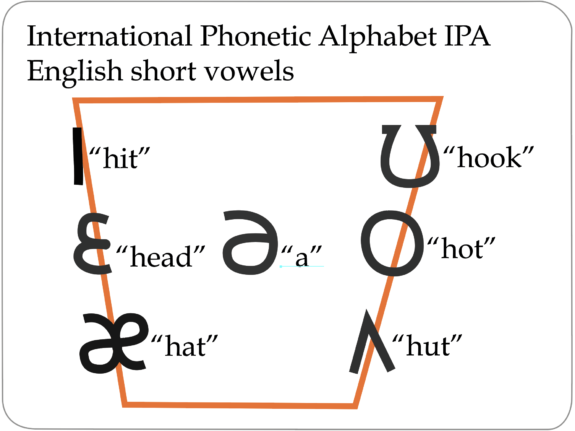
The International Phonetics Alphabet
The IPA and the phonetics of English
The great utility
Speech and language therapists use the IPA to write down the sounds of speech as they are actually pronounced. The IPA is one of the tools of the profession.
The orange shape in the diagram above represents what is known as the ‘vowel space’. The characters show the seven short vowels. The fact that there are seven of these vowels is one of the irreducible problems of ‘Systematic Synthetic Phonics.‘
The fact that there is such a space was first understood by William Holder who could reasonably be called the first ever speech and language therapist any where in the world. From his therapy, it is clear that he understood that the space can be navigated around its outside edge from the top left down to the bottom, along the bottom, and then up to the top right. The fact that it can be SHOWN as a space was first understood by Alexander Melville Bell who could reasonably regarded as one of the first two full time speech and language therapists. It was Daniel Jones who showed that the space is best represented as a rhomboid, as shown above. The whole process of invention here took 300 years from Holder to Jones.
English has (at least) seven short vowels. I say at least because the vowel in the in the evening has the tongue in the same position as in he, she, heat and heap, at the very fop and front of the vowel space, above and beyond the orange rhombus above, what is known as ‘tense’. But it is not the same as the long vowel at the beginning of evening. So this vowel is different from the one in hit, lid and lick. But rather than proposing that there are eight short vowels in English, one with the unique, and very unusual property of being short and tense, it is more economical to say that there are seven short vowels, and that the central vowel in the is just raised to the front (a position which occurs in almost all languages) where it occurs before another vowel, as in the evening.
Most languages just delete one of two adjacent vowels. English just does something different.
Children sometimes say the elephant, the ink, the evening, with the as in the hat or the horse. They just haven’t learnt the raising rule.
English never had the extra two characters necessary for a vowel system with seven positions, in contrast to the five in Latin. Most languages make good the shortfall here. common to all the languages of Northern Europe, with an accent or a stroke through the character. But English has stayed with the Latin characters in their original, plain form. To my mind this oddity of English makes Systematic Synthetic Phonics non-viable.
Limitations
The primary motivations of the English, French and German founders of the IPA would seem to have been the promotion of their respective cultural empires. It would appear that they did not think to invite to the conference at which they formulated the basic principles of the IPA, Jan Niecislaw Ignacy Baudouin de Courtenay, of French and Polish ancestry as his name suggests, who had established and given its name to the phoneme, as a major linguistic category, and the basic unit of IPA currency. Baudouin de Courtenay was working in Russia where he had done his doctoral research. Perhaps it was thought that that made him an enemy given that Britain had recently been at war with Russia. He was overtly political, but not towards the Russian empire. When the Russian revolution happened he was interviewed by the Cheka which was concerned that his loyalities to Poland could encourage a separatism which the new Soviet government did not want to encourage. Unsurprisingly he went to Poland. And there in the early 1920s he set up the world’s first institution dedicated to the training of speech and language pathologists. He was also nominated as President of Poland, but not elected. But his distinctive perspective was not shared by the other founders of the IPA. While it is a useful tool for the broad transcription of incompetent speech, it is not well adapted for the close transcription of very incompetent speech. The idea of such a clinical purpose would seem never to have entered the heads of the founders.
It is also unclear whether there are different styles of transcription or whether different representation of what might seem to be the same phoneme actually represent subtly different phonetic forms, So he is transcribed mostly as /hi:/ in Britain and often as /hi/ and /hih/ in North America.

